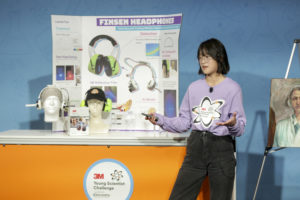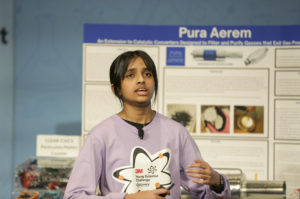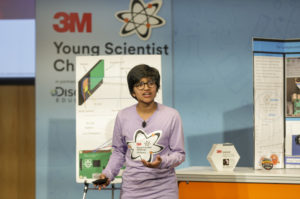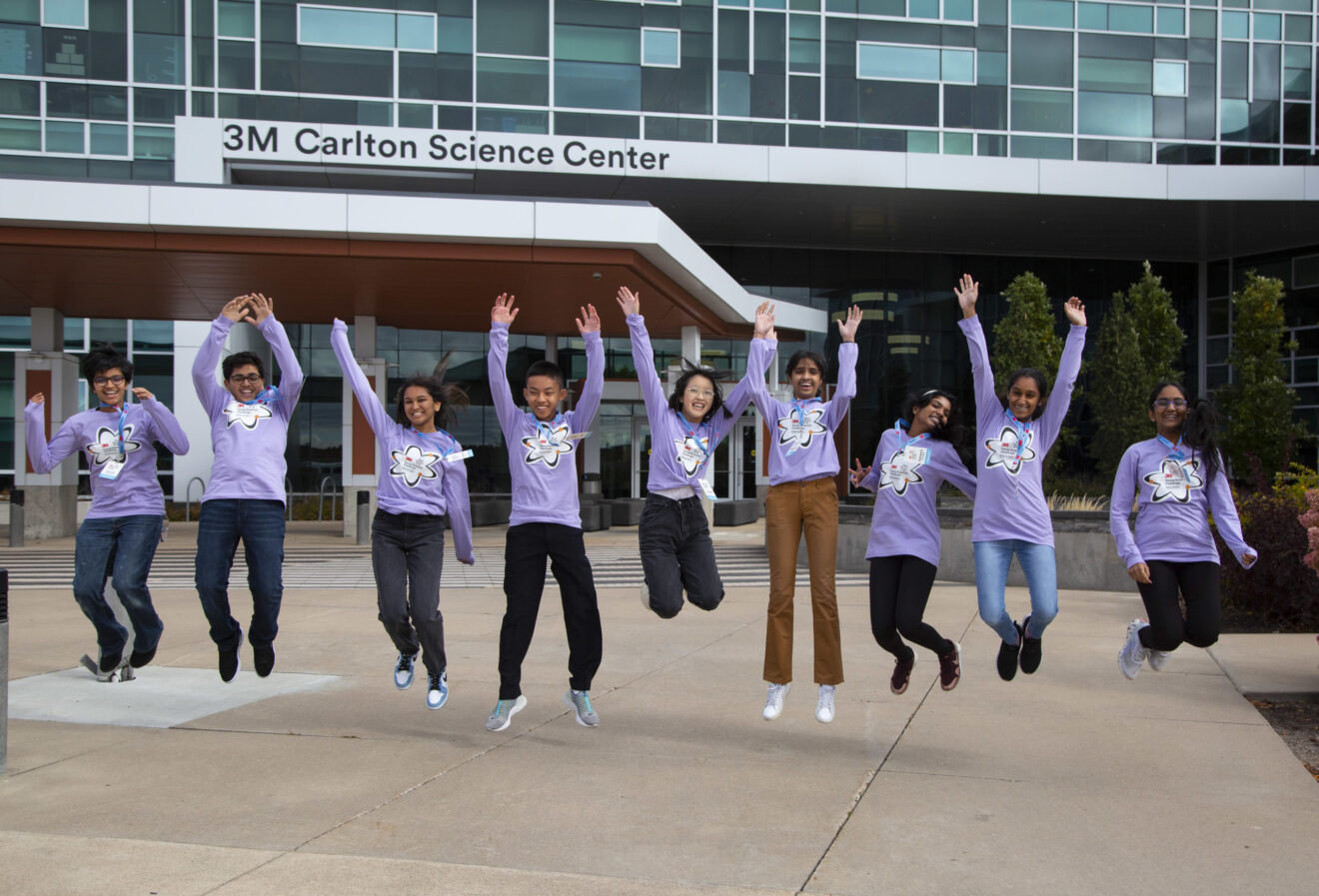The workforce of the present, and especially the future, will need plenty of people conversant in STEM subjects. The earlier educators open students’ eyes to the variety and possibilities, the better. These six students in eighth and ninth grade have taken an early interest in STEM. They’re among the nine finalists of last fall’s 3M Young Scientist Challenge with Discovery Education, and they’ve shared details of their projects with SmartBrief. (The others were unavailable for the Q&A.)
SmartBrief also asked them about their earliest memories of STEM involvement, the challenges they’ve faced and advice for educators who want more students to take STEM classes. These are the students:
Leanne Fan, America’s Top Young Scientist, first-place winner and ninth-grader from San Diego. Project: Finsen headphones designed to treat mid-ear infections using machine learning and phototherapy.
Harini Venkatesh, second-place winner and eighth-grader from Brentwood, N.H. Project: The Comptometrist: An efficient way to determine myopic power.
Shanza Sami third-place winner and ninth-grader from Iowa City, Iowa. Project: Pura Aerem: Leveraging catalytic converters for enhanced filtering efficacy.
John Lee, finalist and ninth-grader from Oviedo, Fla. Project: A novel mos2 electrode for enhancing electrochemical hydrogen production
Samaira Mehta, finalist and ninth-grader from Santa Clara, Calif. Project: OVision: The automatic assessment of ovarian cancer features and mesothelin protein overexpression from histopathological images using deep learning.
Asvini Thivakaran, finalist and eighth-grader from Round Rock, Texas Project: Piezoelectric power generation from automotive tires.
Learn more about each student and their project, and remember to read Part 2 of the Q&A.
When/what was your first exposure to STEM in school (beyond basic math and science)?

Leanne: My elementary school had an after-school group/club that met once a week to do science and engineering experiments! This included building towers with marshmallows and spaghetti and seeing whose tinfoil boat could hold the most weight.
Harini: My first exposure to STEM in school was in first grade, when I attended a workshop held by The Shoulders of Giants, an organization in our locality. This workshop was basically an introduction to STEM for younger students, and I thoroughly enjoyed it! I remember seeing the instructor pop a hydrogen balloon with a lit match, and the explosion that followed is one that’s stuck with me for many, many years!
Shanza Sami: When I attended school science fairs as a young student, I would be amazed at the various displays — how science had various applications in the real world, the impacts it has on lives and how I could explore it as a potential career. School science fairs were the first eye-opening exposures I had to STEM.
John: My first exposure to STEM in school was in 2020 when I was in seventh grade. A fellow friend of mine informed me of a STEM class available at our school. I decided to sign up for the class because I wanted to do a STEM research project. I had a project where I conducted an experiment to investigate how different environments can impact the penetration of E. coli.
Samaira: I was introduced to STEM in kindergarten when our teacher took our class to our school computer lab. There I was introduced to computer science and STEM through basic block-based programming and immediately was so fascinated with the power I gained by creating code.
Asvini: My first exposure to STEM in school was when I was in kindergarten. My teacher showed us how to make a cloud using boiling water, ice cubes, a jar and a match. I am always thrilled seeing the results and it is fun to watch.
When did you know that STEM was a passion of yours?
Leanne: I knew that STEM started being a passion of mine when I started reading about various science topics on my own and asking my teachers questions about science and engineering that weren’t related to class.
Harini: I’ve loved math and science for as long as I can remember. Since the age of 3, I’ve repeatedly stated a wish to become a doctor. I’m not entirely sure from where this ambition came, but I’ve definitely been interested in STEM since a very young age.

Shanza: My greatest inspirations throughout my life truly influenced me to pursue STEM — individuals like Katherine Johnson, Steve Jobs and others that made revolutionary strides in STEM and innovation. I was compelled to use STEM to make a positive impact on the world after seeing these innovators and what their research has done for the world. I began exploring my passion for science through science camps, computer programming, robotics classes and science competitions. Eventually, it was clear to me that science was my passion.
John: In early 2020, when I was in sixth grade, I had a chance to watch many young scientists present their research and ideas at a regional science fair. This encouraged me to investigate what problems there are out in the world and innovate a prototype to solve an issue. Additionally, many present-day scientists, including Mark Rober and Timothy Berners-Lee, motivated me to solve problems existing today in our world.
Samaira: Ever since I was very little, I’ve loved breaking things down things to understand what they comprise; that meant dismantling pens, rebuilding LEGOs and completely obliterating my Nerf guns. Hence, as I grew, that lead to my love for science. I get to break down the processes of our world that we often take for granted and truly understand what make them possible. For instance, questions as simple as “Why is the sky blue and the grass green?” to questions as complex as “What is the universe made of?” can be made clear through the power of science.
Asvini: When I saw that STEM can make the difference, I got to be passionate about it and started to learn more about it. I have always been interested in experimenting with how things work, and I always do research about new ideas. Currently, engineering with technology is helping in many ways to make life easier.
What about your current school/teacher making it easier for you to pursue your project?
Leanne: My science teacher allows me to use the school’s spectrophotometers and labs to conduct experiments. I have also asked many teachers in my school about how certain processes work and have gotten amazing answers.
Harini: At my current school, I’m able to pursue my project in so many ways! We have a Design Lab where I can 3D-print parts and put together my device. Over the course of my journey, I also connected with a doctor in the Boston area, and because of my school’s proximity, I’m able to connect with him in person to discuss and get help on my project, which is absolutely AMAZING!
Shanza Sami: My gifted-learning program teacher, Mrs. Jodie Eilers, was monumental in the process of research for my project. She connected me with individuals to consult with on my findings, provided me with the time and resources to research my idea, and offered invaluable support and encouragement.
John: My STEM teacher from the previous school year assisted in my research by reminding me of upcoming deadlines and providing suggestions on how my project can be improved. She also provided me with documents to keep track of my research and analyze data from my experiments.
Samaira: My eighth-grade science teacher, Mrs. Shannon Deza, teaches at Stratford Preparatory and is the most influential educator as it relates to my participation in the Young Scientist Challenge. Mrs. Deza greatly helped me learn about the biological side of my project by imparting her knowledge of ovarian cancer to me. Since her mother, unfortunately, passed away due to this cancer, she also helped me understand the problems in our current ovarian cancer diagnosis and prognosis system. Through our conversations, I was able to realize that creating targeted plans for each patient was one of the best ways I could aid our doctors.
Asvini: Currently, I am in middle school, and my school is running an after-school club for the kids who are interested in doing the science fair. They assigned a science teacher to run the club, and it is very helpful to go to a competition through school. The teacher is always very supportive and helpful in bringing a project up to speed and taking it to the regional and state science fairs.
What were any obstacles/challenges at the school?
Leanne: I don’t have any major obstacles regarding STEM at school. The biggest challenge for me is just finding the time to work on my project along with all of my homework.
Harini: My only large obstacle, I would say, is time. Because high school at my current school is much more demanding than middle school, I have less time to focus on my project and STEM overall, which means that I have to manage my time carefully, and I have to work around my classes, the hours that the Design Lab is open, and get sleep and adequate food while doing all of the rest of it. I haven’t quite mastered the art, but I’m sure that I’ll get there!
Shanza: Pacing was often a big obstacle — while some students would process information faster, others would prefer to learn at a slower pace. It creates a learning gap that the traditional school curriculum can sometimes not compensate for within classrooms. Extended learning programs and after-school activities were great outlets for me to continue learning at a faster pace throughout my education experience.
John: To test my newly developed electrode prototype, I needed to access a laboratory where I would be able to conduct a wet chemistry lab experiment. I had a difficult time trying to find someone who would be able to assist with this.
Asvini: There are not many challenges or obstacles I faced during my past at school. I really enjoy my school time. Middle schools should have science labs with many hands-on activities for the kids. If we experiment with them at school, we can understand the concept more easily than watching videos and presentations.
Why did you choose your project topics, and why are they important to you?
Leanne: I chose my project, Finsen headphones, because ear infections have always been a problem in my family. I read more about it and found out about how much hearing loss in children can be prevented through early detection and treatment of mid-ear infections, so I wanted to find a low-cost solution to detect and treat them.

Harini: My sister had her first eye check-up in mid-2021, and she came back, telling me that the exam was really long, and she didn’t even know what was clear or not when the doctor asked. I was, at the time, involved in a program called HOPE (Helping Our Peers Excel) at my school, which allowed students to work with special-needs peers for one class period. Many of these students had glasses, and I realized that if my sister and many of my peers faced this issue, then how much harder would it be for those who couldn’t communicate effectively? I wanted to do something about that, and the Comptometrist was born!
Shanza: I created my innovation, Pura Aerem, to serve as an extension to catalytic converters to purify the gases that exit gas-powered vehicles. This reduces overall carbon emissions, addressing air pollution and climate change. I was compelled to tackle this issue after my experience of being hospitalized and diagnosed with pneumonia in India. There, the air quality is substantially worse, and it devastated me to see that many disadvantaged people living in developing areas were constantly exposed to this. I decided to address gas-powered vehicle emissions, as they are one of the largest contributors to greenhouse gas emissions.
John: Prior to my research project, I read several articles about global warming and instantly knew that I wanted to solve this problem. I knew the problem was relevant and important to me because global warming would eventually have a strong impact on me as well as those that I know, such as friends and family.
Samaira: It was in my eighth-grade science class that I learned about the fatality rate of ovarian cancer. Unfortunately, my own science teacher’s mother passed away due to this disease. Like her, about 300,000 cases of ovarian cancer are confirmed each year, and tragically 200,000 of those patients die. I have always been inclined towards and fascinated by some of the technologies in our world today. So, I immediately knew I could use my skills in artificial intelligence to help tackle this issue.
When I was 11, I developed a mechanism to simplify concepts as complex as artificial intelligence into something any kid could understand, into a board game called CoderMindz. For CoderMindz, the world’s first board game that teaches AI concepts, I have received various awards, including the Davidson Fellows Honorable Mention. Being one of the youngest people ever to earn this award has inspired me to continue to use the power of AI to make a profound impact on the world around me. Therefore, when I learned about how deadly ovarian cancer is because it is not accurately diagnosed, I decided to put my depth of knowledge in AI to aid doctors in precision medicine.
Asvini: My project’s main goal is to help reduce greenhouse gas emissions from the transportation sector, and this will ultimately help to solve global warming. Global warming, climate change and air pollution are some of the biggest global issues that our generation is facing today, and my project will help to bring a real-life solution that could possibly be an antidote for this issue.
The other finalists, who were unavailable for the Q&A are: Amritha Praveen from Buffalo Grove, Ill., an eighth-grader at Aptakisic Junior High School; Sahasra Swargam from Portland, Ore., a ninth-grader at West View High School; and Daniel Thomas from Colleyville, Texas, a ninth-grader at Colleyville Heritage High School.
Don’t forget! Learn more details about each student and their project, and read Part 2 of the Q&A. Read more about the 3M Young Scientist Challenge with Discovery Education.
Diane Benson Harrington is an education writer at SmartBrief. Reach out to her via email, Twitter or LinkedIn.
Opinions expressed by SmartBrief contributors are their own.
_________________________
Subscribe to SmartBrief’s FREE email newsletter to see the latest hot topics on EdTech. It’s among SmartBrief’s more than 250 industry-focused newsletters.
